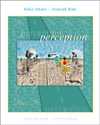|
 |  Perception, 4/e Robert Sekuler,
Brandeis University
Randolph Blake,
Vanderbilt University
Hearing and Listening
Chapter Outline- THE RANGE AND LIMITS OF HEARING
- HEARING LOSS
- Conduction Hearing Loss and Possible Remedies
- Sensorial/Neural Loss
- Age and hearing loss
- Noise exposure and hearing loss
- Drugs and hearing loss
- Some Perceptual Consequence of Impaired Hearing
- Compensating for Hearing Loss
- Hearing aids
- Cochlear implants
- The Range of Hearing in Animals
- NOISE MASKING AND CRITICAL BANDS
- LOUDNESS PERCEPTION AND DISCRIMINATION
- How Loud is Loud?
- Neural Bases of Loudness Perception
- Loudness Discrimination
- PITCH PERCEPTION
- What is Pitch?
- Pitch and frequency are not synonymous
- The Neural Bases of Pitch Perception
- Perfect Pitch and Tone Deafness
- SOUND RECOGNITION: JUDGING WHAT THE SOURCE OF A SOUND IS
- Perceptual Organization of the Auditory Stream
- Common spectral content
- Common time course
- Spectral harmonics
- Familiarity
- SOUND LOCALIZATION: JUDGING WHERE A SOUND ORIGINATES
- Interaural Intensity Differences
- Interaural Time Differences
- The Cone of Confusion
- The Effectiveness of Interaural Time and Intensity Differences
- Sound (Mis)Localization
- Design features that minimize mislocalization errors
- Mislocalization: Sound heard through headphones
- Mislocalization: Ears versus eyes
- Do the eyes control sound localization accuracy?
- SOUND LOCALIZATION: JUDGING THE DISTANCE OF A SOUND SOURCE
- The Cocktail Party Effect: Masking and Unmasking Sound
- PERCEPTION OF SPEECH SOUNDS
- The Sounds of Speech
- The Neural Analysis of Speech Sounds
- Factors Influencing Speech Perception
- The role of feature detection in speech perception
- The role of context in speech perception
- The role of speech boundaries and intonation in speech perception
- Fine Temporal Structure in Language-Based Learning Impairments
|
|
|



 2002 McGraw-Hill Higher Education
2002 McGraw-Hill Higher Education

 2002 McGraw-Hill Higher Education
2002 McGraw-Hill Higher Education